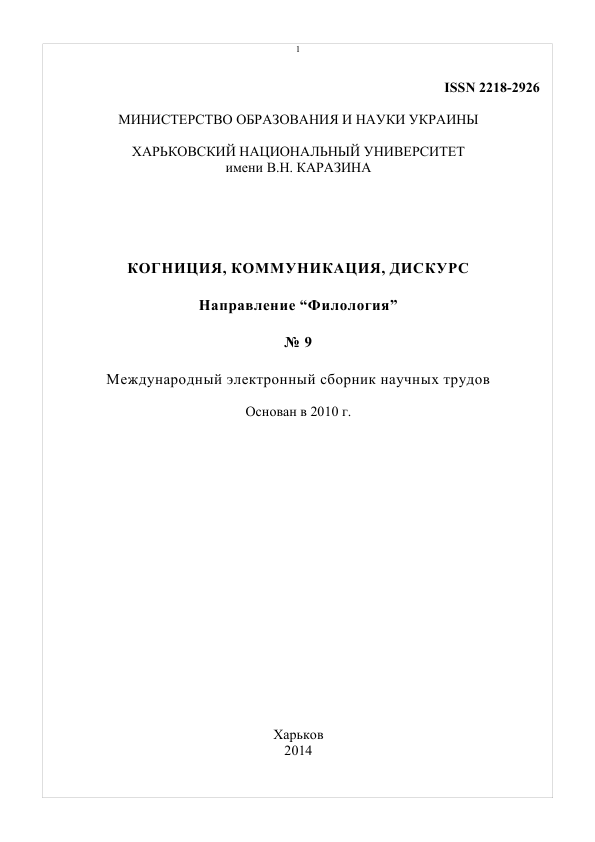Conceptions of Creativity in Translation
Abstract
Creativity in translation is presented as a dualistic anthropogenic phenomenon uniting both activity aimed at producing new products with these products themselves embodied in language units of different levels and speech formations – texts. On the basis of the principle of ontological relativity main ontologies of translation were singled out together with relevant conceptions of translator’s creativity – language-oriented, text-oriented and activity-oriented.
Downloads
References
Benjamin, W. (2000). The Task of the Translator. An Introduction to the Translation of Baudelaire’s Tableaux Parisiens. In: L. Venuti (ed.). The Translation Studies Reader. London and New York: Routledge, pp.148-159.
Bernardini, S. (2001). Using Think-Aloud Protocols to Investigate the Translation Process: Methodological Aspects. Target, 13(2), 241-63.
Biguenet, J., and Schulte, R. (1989). The Craft of Translation. Chicago: University of Chicago Press.
Britannica Concise Encyclopedia. Available at: http://www.britannica.com/.
Bіlodіd, І. K., Buriachok, A. A., Vynnyk, V. O., Hnatiuk, H.M. et al. (Eds.) (1979). Slovnyk ukrainskoi movy [A dictionary of the Ukrainian language] (Vol. 10). Kyiv: Naukova dumka Publ. (in Ukrainian)
Cronin, M. (1995). Keeping One’s Distance: Translation and the Play of Possibility. TTR: traduction, terminologie, redaction, 8(2), 227-243.
Eco, U. (1894). The Role of the Reader. Bloomington: Indiana University Press. Fedorov, A.V. (2002). Osnovy obshhej teorii perevoda (lingvisticheskie problemy) [Basics of the general theory of translation (linguistic issues)] (5 th ed.). Saint Petersburg.: SPbU Faculty of Philology Publ., Moscow: FILOLOGIJA TRI Publ. (in Russian)
Guilford, J. P. (1967). The Nature of Human Intelligence. N.Y.: McGraw-Hill. Hermans, T. (1996). Norms and the Determination of Translation. In: R. Alvarez and M. Vidal (eds). Translation, Power, Subversion. Clevedon: Multilingual Matters, pp. 25-51.
Jakobson, R. (1981). Poetry of Grammar and Grammar of Poetry (Vol.3). The Hague: Mouton.
Kerr B. Encyclopedia of Giftedness, Creativity, and Talent. Available at: http://knowledge.sagepub.com/view/giftedness/n166.xml.
Komissarov, V.N. (1999). Perevodovedenie v XX veke: nekotorye itogi [Translation studies in the 20 th century: some results]. Tetradi perevodchika – Translator’s Notes, 24, 4-20. (in Russian)
Kussmaul, P., and Tirkkonen-Condit, S. (1995). Think-Aloud Protocol Analysis. Translation Studies TTR: traduction, terminologie, redaction, 8(1), 177–199.
Lefevere, A. (1992). Translation, Rewriting and the Manipulation of Literary Fame. London and New York: Routledge.
Lefevere, A. (2000). Mother Courage’s Cucumbers. Text, System and Refraction in a Theory of Literature. In: L. Venuti (ed.). The Translation Studies Reader. London and New York: Routledge, pp.233-249.
Loffredo, E., and Perteghella, M. (2007). Introduction. In: E. Loffredo and M. Perteghella (eds.). Translation and Creativity: Perspectives on Creative Writing and Translation Studies. London: Continuum, pp. 1-16.
Martyniuk, A.P. (2012). Slovnyk osnovnykh termіnіv kohnіtyvno-dyskursyvnoi lіnhvіstyky [Dictionary of basic terms of cognitive-discursive linguistics] Kharkіv: V. N. Karazіn KhNU Publ. (in Ukrainian)
Nikolaou, P. (2007). Notes on Translating the Self. In: E. Loffredo and M. Perteghella (eds.). Translation and Creativity: Perspectives on Creative Writing and Translation Studies. London: Continuum, pp. 19-32.
Norman, D.A., and Bobrow, D.G. (1975). On Data-limited and Resource-limited Processes. Cognitive Psychology, 7, 44-64.
Paz, O. (1992). Translation: Literature and Letters. In: R. Schulte and J. Biguenet (eds.). Theories of Translation from Dryden to Derrida. Chicago: Chicago University Press, pp. 152-163.
Prigogine, M., and Patterson, T. (2006). The Scientist and Prigogine’s futur créateur. Dialectic. International Journal of Ecodynamics, 1(1). Available at: http://www.tristapatterson.com/pdfs/ PattersonAndPrigogine.pdf.
Quine, W.V. (1968). Ontological Relativity. The Journal of Philosophy, 65(7), 185-212.
Rebrii, O. (2013). Think-Aloud Protocols as a Means of Studying Cognitive Mechanisms of Translator’s Creativity. The Advanced Science: open access journal, 4, 11–14.
Riabtseva, N. Perevodovedenie v Rossii i za rubezhom. Ch. 2. Analiz jempiricheskogo materiala. [Translation studies in Russia and beyond. Part 2. A case study]. Available at: http://www.iling-ran.ru/Riabtseva2.doc.
Tarnaeva, L.P. (2010). Kreativnye mehanizmy rechevoj dejatel'nosti perevodchika: lingvodidakticheskij aspekt problemy [Creative mechanisms of the translator’s speech activity: linguistic and didactic aspects of the problem]. Vestnik Tverskogo gosudarstvennogo universiteta. Ser.: Pedagogika i psihologija – Herald of Tver State University. Pedagogy and Psychology Series, 35, 129-134. (in Russian)
Torrance, E.P. (1988). The nature of creativity as manifest in its testing. In: R.J. Sternberg (ed.). The nature of creativity. New York: Cambridge University Press, pp. 43-73.
Tsvilling, M.Ja. (1999). Perevodovedenie kak sintez znanija [Translation studies as knowledge synthesis]. Tetradi perevodchika – Translator’s Notes, 24, 32-37. (in Russian)
Zimnjaja, I.A. (2001). Lingvopsihologija rechevoj dejatel'nosti [Linguistic philosophy of speech activity]. Moscow: Moscow Psychological-Social Institute Publ.; Voronezh: NPO «MODJeK» Publ. (in Russian)
Authors, who publish with this journal, accept the following conditions:
The authors reserve the copyright of their work and transfer to the journal the right of the first publication of this work under the terms of the Creative Commons Attribution License (CC BY), which allows other persons to freely distribute a published work with mandatory reference to the authors of the original work and the first publication of the work in this journal.
Authors have the right to enter into separate additional agreements for the non-exclusive dissemination of the work in the form in which it was published by this journal (for example, to post the work in the electronic institutions' repository or to publish as part of a monograph), provided that the link to the first publication of the work in this journal is given.
The journal policy allows and encourages the authors to place the manuscripts on the Internet (for example, in the institutions' repositories or on personal websites), both before the presentation of this manuscript to the editorial board and during review procedure, as it contributes to the creation of productive scientific discussion and positively affects the efficiency and dynamics of citing the published work (see The Effect of Open Access).




